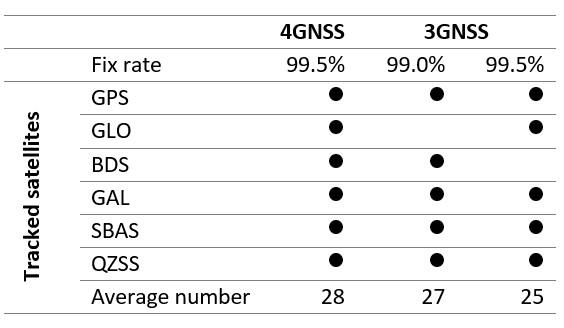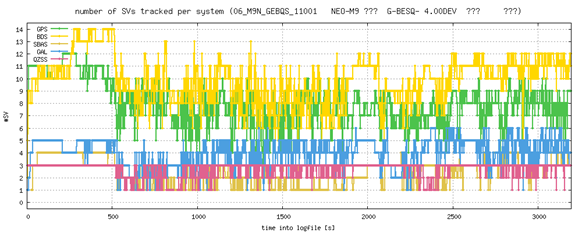
- Support portal
- Evaluation Kits and partner products
u-blox Support
- Product documentation
Documentation
- Investor relations
Investor relations
Tech
|
05 Nov 2020
Tracking a fourth constellation increases performance in dense urban environments – and it increases the technology’s overall resilience to disruptions.

Back in 2015, the u-blox M8 GNSS receiver platform made major inroads in improving positioning performance, with the ability to concurrently track two and later three GNSS constellations simultaneously. Roughly tripling the number of satellites within line of sight at any given time brought significant benefits: Not only could positions be computed more accurately using the best signals from a larger set; it also significantly shortened the time to first fix, in particular in challenging urban environments.
Then came u-blox M9 and u-blox M10, which brought up the number of GNSS constellations that can be tracked at any given time to four. This begs the question: how much improvement can tracking yet another GNSS constellation really bring?
Earlier this year, we took to the road in locations in the US and Asia to test our latest generation of u-blox M9 GNSS receivers. Here’s how tracking four constellations fared versus tracking only three.
A challenging road test

As the images of our testing site, shown above, make clear, we weren’t interested in an easy open-sky scenario. What we were after was a direct comparison of performance in a common yet extremely challenging environment: a metropolitan downtown district with deep urban canyons.
Because sky-scrapers limit the portion of the sky, and thus the number of satellites that lie within a GNSS receiver’s line of sight, urban canyons make it extremely difficult for GNSS receivers to latch onto signals emitted by orbiting satellites for long enough to be able to locate themselves continuously. By increasing the number of satellites that they can draw on, an additional constellation should, at least in theory, make a significant difference.
Slight improvements in satellite availability

And our measurements bear this out. Although the position fix rate improvement we recorded is not dramatic – we were already achieving fix rates around 99% using three constellations - tuning in to four constellations in Singapore, our receiver tracked 28 satellites, achieving a fix rate of 99.5 percent, versus 27 (resp. 25) satellites tracked at a fix rate of 99 percent (resp. 99.5 percent) when tuning into three. The results were less clear cut in Chicago, where the fix rate was only slightly better, at 99.2 percent versus 98.7 percent (resp. 99.3 percent).
Slightly higher number of visible satellites
The two graphs below represent the number of GNSS satellites that our test receivers tracked per satellite system, as well as the number of SBAS (Satellite-based Augmentation System) signals they receive. In the first graph, we restricted the number of constellations that could be tracked concurrently to three, with the maximum total number of tracked satellites limited to 30 by the firmware. In the second graph, we let our receivers track four constellations, again with the same maximum limit, but with one additional constraint: the number of tracked satellites from each constellation was limited to eight.
Given the large number of satellites in orbit, both receivers were consistently close to maxing out the number of individual satellites they could track simultaneously. There was, however, one important difference. With three constellations, the receivers had to make do with any satellite that happened to be within line of sight. When four constellations are tracked, the receiver firmware can be picky and select only the subset of satellites whose signals provide most information.

Number of space vehicles (SV) tracked per system in Singapore when tracking three GNSS constellations

Number of space vehicles (SV) tracked per system in Singapore when tracking four GNSS constellations
The benefits of tracking four GNSS constellations are (i) greater diversity of satellite signals, and (ii) better signal quality. As we’ll see in the next section, these benefits translate directly into improvements in position and velocity accuracy.
Improvements in position and velocity accuracy
Back in the computer lab, we analyzed the same road test data to compare the accuracies of our position and velocity readings when using three versus four GNSS constellations.

The numbers speak for themselves. In both cases, we observed improvements in the 50 percent positioning and velocity errors (CEP50), and these improvements grew as we increased the percentage of measurements considered. Notably, adding an additional constellation dramatically reduced the magnitude of the outliers – by more than a factor of three for 2D position, and by almost a factor of two for 2D velocity. Another important finding is that all applications that suffer from position jumps (outliers) benefit greatly from the 4GNSS reception.
Overall benefits of tracking more satellite constellations
As we’ve seen, tracking four GNSS constellations only leads to a marginal increase in the time that GNSS receivers spend with a fixed position. For anyone using a GNSS receiver, this means that their GNSS receiver will deliver a position and velocity estimate regardless of whether they are tracking three or four constellations. But because the GNSS receiver can pick and choose the best GNSS signals from a greater diversity of satellites and constellations, it can provide more accurate position and velocity estimates.
The quantitative results reported here only tell one part of the story. As mentioned in the opening paragraph, tracking three GNSS constellations made the overall positioning solution more robust – be it to malicious RF interference, to accidental GNSS service disruptions such as Galileo’s one-week service outage in July 2019, or to deliberately withheld service, e.g. in times of war. Tracking a fourth constellation further supports these advantages.
Bernd Heidtmann
Product Manager, Product Strategy for Standard Precision GNSS, u-blox